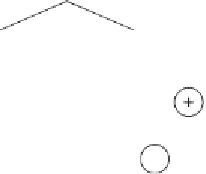Information Technology Reference
In-Depth Information
?/?aa*-?aa???a?29453350-{6,9,2,7,3,1,6,7,1,0}-[14] = 829.5259
//++*++aaa?a?a?81488174-{7,9,3,8,7,8,4,2,7,5}-[15] = 822.359
+a++*+/??aa????76298530-{6,0,0,7,0,7,0,4,8,4}-[16] = 789.711
/++?++a????a?a?32322331-{2,4,5,4,0,6,3,4,2,9}-[17] = 836.1209
//*++++aa?a??aa93330420-{7,9,3,8,7,8,0,2,7,5}-[18] = 822.1262
+++-+aa?a?a??a?93335420-{2,4,5,4,0,6,3,6,2,9}-[19] = 834.5455
Note that the best individual of this generation (chromosome 1) encodes
exactly the same structure as the best of the previous generation (compare
Figures 5.11 and 5.12); indeed, their sequences in the head/tail domain match
perfectly. However, the Dc domain came from another individual, most prob-
ably through recombination, as they are completely different. And although
the set of RNCs was inherited (with just one mutation) from the best of the
previous generation, the new Dc allowed the fine-tuning of the numerical
constants by enabling a different set of constants to get expressed. And thanks
to this modification, a new individual with maximum fitness was created,
matching perfectly the target function (3.19).
a.
01234567890123456789012
*+/+a++??aa????20925007
b.
ET
C = {6, 0, 0, 7, 0, 7, 0, 5, 8, 4}
a
2
y
3
a
c.
a
2
a
a
0
6
4
0
Figure 5.12.
Perfect solution to the simple symbolic regression problem. This
program was found in generation 7 and has maximum fitness.
a)
The chromosome
of the individual with its random numerical constants.
b)
The fully expressed
individual.
c)
The corresponding mathematical expression. Note that it matches
perfectly the target function (3.19).
5.6 Three Approaches to the Creation of NCs
In this section we are going to analyze three different approaches to the
problem of constants' creation in evolutionary computation by comparing the
performance of three different algorithms. The first, called GEA-B (from
basic GEA), creates numerical constants from scratch if necessary, but no









